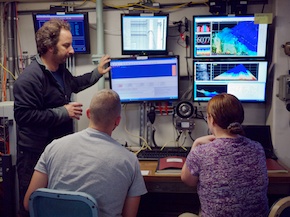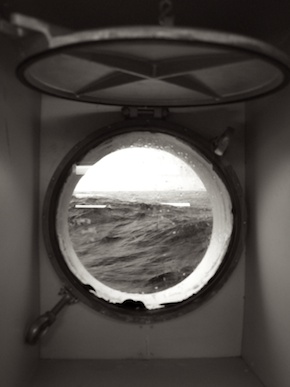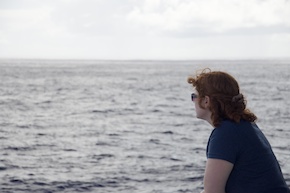The R/V Thomas G. Thompson left Honolulu on November 5, 2011 heading toward the Western Pacific. This expedition journal was written by cruise participants and uploaded about once per weekday, depending on internet availability.
November 28, 2011: Wake, Work, Try to Sleep, Repeat
“Where do you live?” On the R/V Thomas G. Thompson, this question does not refer to your current residence, mailing address, or hometown; it refers to your berthing area (living space) on the ship and/or cabin number. Generally it is most frequently asked in the early morning shifts when one or more watchstanders is missing and needs a reminder to wake up.

Not Facebook (Credit: Will Koeppen)
There are eight geophysics watchstanders for this cruise and all are students and post-graduates. We each carry out two four-hour shifts per day covering the full twenty four hours. Some shifts are harder to adjust to than others, but they all allow us eight hours between shifts to sleep or do other things. The shifts are broken up into three slots, 12–4, 4–8, and 8–12. I was assigned the 8–12 slot, which means that I work the 8 a.m. to noon and 8 p.m. to midnight shifts, which are pretty easy to adjust to. Other watchstanders were not so fortunate, but everyone seems to have adjusted well and for the most part arrive to their shifts on time and chipper. We only have four-hour shifts because each shift involves monitoring various computer screens displaying the geophysical data being collected. Four hours at a time is probably the threshold for holding a watchstander’s attention to ten computer screens. Most of us probably spend a significantly longer time staring at television and computer screens at home, but monitoring geophysical data collection is much more arduous and far less comedic than spending seven hours on Reddit.

At least the lab is above sea level
(Credit: Will Koeppen)
Most tasks on a moving research vessel are far more challenging than their terrestrial counterparts, especially during large swells. For example, soup is not my favorite choice at meal times due to the complex movements required to obtain the soup and carry it successfully to a table while the ship pitches and rolls. Walking around the ship during rough weather can also be both amusing and depressing, and most people walking around the ship during a storm look like intoxicated toddlers. Going up a flight of stairs you might feel weightlessness, followed by the feeling of carrying a bag of bricks on your back, usually one after the other, an intriguing and sometimes frightening sensation.
Most watchstanders try to get some sleep after their second shift of the day. In general, the amount of good sleep one is able to obtain is governed by the location of your cabin, your shift schedule, light emitting items within the room, the mattress and room temperature, how light of a sleeper you are, and your roommate. Many of the science party stays in the berthing area in the low and forward part of the ship situated below the main lab. In this area, the ship’s engine noise is more apparent than above in the labs and crews' quarters. The Thompson's main engines are specialized Z-drive thrusters, which are relatively quiet, but my cabin is next to the ship’s secondary bow thruster, a loud engine used to add side-to-side maneuverability to the Thompson. It always seems to turn on as I'm trying to fall asleep, but with some earplugs and/or a music-playing device it is tolerable. The mattresses on the Thompson are actually quite comfortable, and their soft foam accommodates you as you are being pushed down into the mattress and then lifted up to rest lightly on top with each passing wave. I personally have a low-level of tolerance for light when trying to fall asleep and unfortunately my room has a plethora of light-emitting devices. However, this can be easily remedied by using the blackout curtains hanging around each bunk for privacy. Each cabin has its own thermostat (most are functional), and the provided linens and blankets are adequate for maintaining minimum body-heat level required for survival, unless you enjoy polar room temperatures and happen to live with a reptile.

Ashley, adjusted (Credit: Will Koeppen)
Even when the bow thruster is not operating, other noises in our cabins include rattling drawers, creaking walls, waves slapping the hull near your head, a sink with a drain that can sound like someone's using a small hammer on the pipes, and a toilet that flushes like a jet engine. In addition, each cabin berths two people, and most of us have roommates with opposing work schedules, so coming and going silently is a skill one needs to master. The general consensus seems to be that it's better to turn on a light and be quick and quiet rather than using the failing light of your non-working cellphone and stumbling into the metal furniture of the room. Overall I have adjusted to sleeping on the Thompson and am usually well-rested for my morning shift, but I am also fortunate enough to have a non-snoring, healthy, and relatively noise-free ninja for a roommate. ♦
